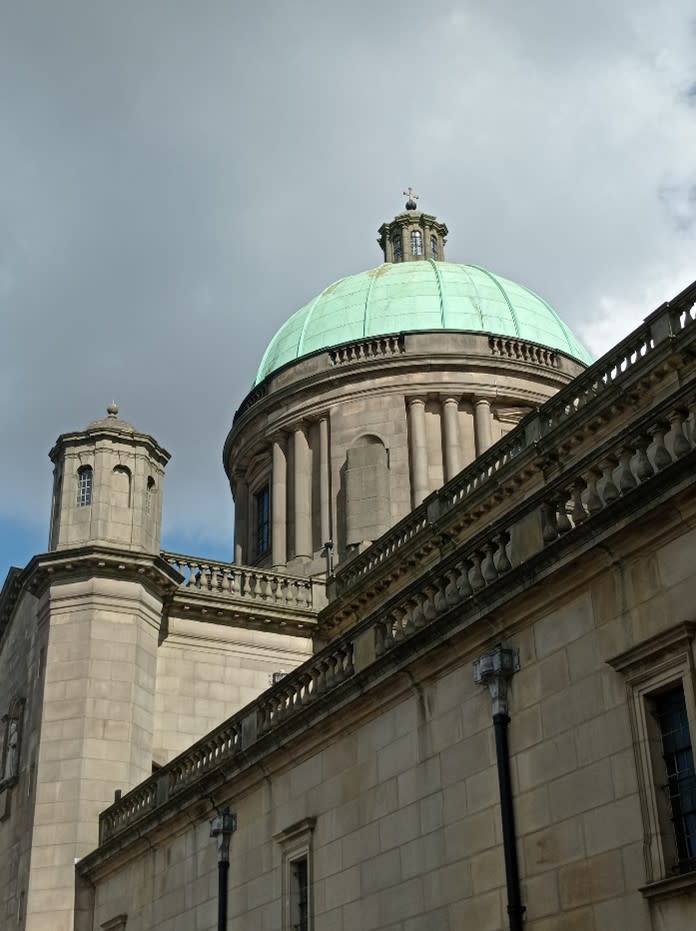It is true that we can find beauty everywhere. Sometimes in obvious aspects like tangible monuments or breath-taking landscapes that cannot escape from our senses, and sometimes in more subtle ways. The latter is the case of The Birmingham Oratory. Located near Hagley Road, one of the busiest roads within the city, this place seems nearly unnoticeable to most of the people that walk past its walls daily. Actually, I did not know the Oratory until I got the chance to visit it in the Birmingham Heritage Week.
My tour started right at the heart of the Oratory. A guy named Colin was the person who guided me and the rest of the expedition through the church while explaining everything. From historic facts about the place’s construction to precise details about the lives of two key characters for Birmingham’s Oratory. The first of these personalities was St. John Henry Newman.

Birmingham Oratory’s dome. Image: @davidtravelwriter
Born and raised in London, Newman dedicated himself to the Catholic Church after his conversion from Anglicanism. Also, he was responsible for establishing an oratory in Birmingham, firstly in Digbeth (an old gin distillery was transformed into a chapel) and later in Edgbaston, which is the current location of the Birmingham Oratory.
Newman and his companions had a massive positive impact in many districts of the city. Their actions propelled social and religious projects of all sizes and shapes in places such as Deritend, Ladywood, Handsworth, or Bournville. However, Newman’s main legacy would be the construction of the mentioned oratory which is dedicated to St Philip.
After getting to know a little bit about Newman’s life, I entered the Oratory. As soon as I raised my eyes, I realized why the place is known as Birmingham’s Little Rome. The interior and decorations of the chapel reminded me of my visit to St Peter’s Basilica during my trip to the Vatican City. Twelve pillars made of marble sustain the whole beauty and history of the Oratory. This dozen structures were constructed in Italy and brought by boat to Bristol, before arriving to Birmingham via its extensive canal network.
Apart from the pillars, I spotted 6 different side chapels. Each one of them was dedicated to a specific saint, being Saint Mary’s the largest and prettiest. This space is supported by two wide pillars which, according to history, were supposed to be placed in Westminster Cathedral in London. Above each of the side chapels there are colourful mosaics, but the one that outstands is the one behind the altar which reflects the Coronation of Saint Mary at Heaven.

Main altar of the Oratory. Image: @davidtravelwriter
The tour took me to a room dedicated to St Philip, founder of the first-ever oratory. Here, visitors can appreciate a painting of the saint when he was a child, as well as a little collection of relics belonging to him. Also, there is a wax figure of St Philip. Opposite to this chamber, there is another one that stands as a tribute to St John Henry Newman. In this second room, some obituaries brought from the original church founded in Digbeth can be seen. However, the relics of Newman were stolen a few years back. Despite this terrible event, the oratory is still considered Newman’s shrine.
Another interesting and worth visiting highlights include the Oratory’s courtyard, the skeleton of St Valentine (taken all the way from Rome’s catacombs to Brum), the church’s dome, the two canopies, and the old-fashioned organ. Additionally, there is the St John Henry Cardinal Museum which gives a wider perspective of Newman’s life and work. Here, you can admire a collection of personal objects belonging to the cardinal.
For those of you who, like me, treasure elements of history and art, the Birmingham Oratory is a must see. Feel free to visit it and interact with the relentless volunteers who keep the place operational and fuel the spirit of heritage conservation. To conclude my article, I would like to thank Colin for taking the time of showing me the secrets of the Oratory, and to the organizers of the Birmingham Heritage Week for including this incredibly beautiful hidden gem in the festival’s programme.
